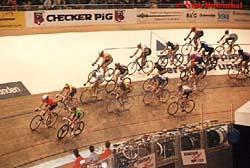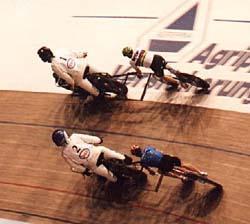|
An Introduction to - Track Cycling The Berlin Six 1999 - An insider's reportBy James Cushing-Murray*
Six thousand people, rock music, light shows, singing, whistles, Miss Germany, cheerleaders, Esso tigers dancing in the aisles, middle-aged women downing shots and beer and more beer, a huge gourmet restaurant, beer stands everywhere, giveaways, 250 meters of 45 degree banked wood, bicycles and wheels; and there you have it - the Berlin Six Day: part serious racing, circus and entertainment. Six day racing began in the United States. The most popular six day was held in Madison Square Garden and the two-man madison takes its name from there. In fact, the first Berlin six day held in 1909 was won by Floyd MacFarland and Jimmy Moran both of the USA. Other than interruptions like wars and stadium reconstructions, the Berlin six day has continued unabated. Six day races used to go on 24 hours a day with the rider sleeping in little cabana-type huts but today the racing usually starts at 6:00 pm and goes on to 2:00 am. Every evening the madison teams did at least two madisons, and filled in their schedule with miss and outs, points races and derny paced races. In between this, there were pure sprinters doing three-up sprints, and steher (stayer) races. The madison had eighteen teams on a 250 meter track. The main goal was to gain laps and points. The team on the same lap with the most points wins at the end of six days. Points were accumulated in many events such as a miss and out but laps were only gained during the madison. The sprinters would do a 250 meter time trial for seeding and be divided up into groups of 3 for one sprint. Stehers (stayers) are riders who motorpace behind stripped-down BMW motorcycles with straight exhausts doing over 50 mph. They would usually do a 100 lapper each night. The evening would often begin with one half of the madison teams doing various races but usually a six lap race with sprints every three laps. On the sprint lap, the music would pick up and people would clap to the beat as the riders wound up the sprint. Then the riders on the track would throw in their other half who would come up from the apron and there would be another six lapper and so on.
Often the points race would be followed by a derny paced race which was a real crowd favorite. Nine identical special dernies without rollers would fire up spewing two stroke exhaust fumes everywhere and pick up their riders. They had one comical looking derny rider who usually won or placed to the crowd's joy. While points were important, the teams knew who was on the same lap and who had the most points so some of these races were for fun and meant to be crowd pleasers. The madisons were serious, the main goal was to gain laps. Riders were so good they never came off the back. The Italians seemed to dominate the racing and ultimately won (so it couldn't be fixed if Italians won in Germany). Silvio Martinello, Marco Villa and Adriano Baffi were some of the Italian riders. Most of the riders were road sprinters, track point racers or pursuiters riding normal track bikes, clippless pedals and spoked wheels. All wore helmets but the old-style hairnets were the vogue. Helmets may not be too important because only one crash happened in six days of continuous racing. Madisons are ridden as two man teams. One rider is riding in the race with the field and the other rider is on relief. When the racing rider comes around, the relief rider drops down and is thrown in via an arm sling becoming the race rider. Exchanges could and were done everywhere even in the middle of sprints or at the end of the sprints. And exchanges were flawless. I only saw one or two missed exchanges. Most of the races were an hour.
One of the amazing things was watching the lead rider in an 18 rider paceline pull up to go to the back, ride up the track through relief riders, riders making exchanges, drop back on the back without missing a beat. Or riders making exchanges right on the finish line after a sprint when their rider was finishing a full out sprint. The sprinters led by 1999 world champion Jans Fiedler had their own series. Unlike the madison riders, funny bikes and double toe straps ruled. At over 225 lbs, they were pure sprinters. While the outcome of each race was important, what happened in between, as I learned, was for entertainment. One rider, Anthony Peden, from New Zealand was the bad guy who pushed and shoved earning the wrath of the audience. Usually the pushed and bumped riders would shake their fist at him and look for sympathy from everyone including the crowd. But on the second night I walked to a part of the track overlooking the rider's area and there were all six sprinter sitting in a circle joking with each other. And every night the group containing Fiedler did a beautiful track stand bunny hopping their bikes into the most photographical position. A picture of this was sure to show up in a Berlin paper and the crowd loved it. Each night the previous night's record would be broken and so on. The final night they did a six minute track stand which didn't look easy. By the way, in their time trials, they often approached 45 mph. Jans Fiedler is an amazing rider. Huge but very young looking. One night while watching him stretch. I watched him drop down into a full split, all 225 lbs of him. Then instead of touching his hands to the ground, he touched his head - talk about limber. I wondered about steroids but discounted the possibility mainly because it looked like Fiedler had one of those 18 inch bratwursts available at the foodstands stuck in his tight skinsuit. (I'm sorry, but it was too obvious and startling not to notice). The steher (stayer) racers were amazing too. Eight stripped down BMW boxers with straight exhausts fired up and picked up their riders. The speeds never went under 40 mph and often went up to 50 mph. Riders riding track bikes with 26 inch front wheels and front forks reversed banging into the rollers at 50 mph was exciting to watch. Again, they tried to please the audience and often during a 100 lappers riders would make a big move from back to front over the top of the track to the cheers of the fans. The fans were great most coming by train or subway. They put on extra trains to run late at night so people could remain until the end and often the crowd didn't begin to thin out until after midnight. The fans loved to sing, blow whistles and clap their hands. After each race they would stand an applaud the winning riders singing to a nice Latin beat "ole, ole, ole, ole, you are the champion.". They had plenty of polkas to sing along with too. Beer and bratwurst was about $3 each and they had a gourmet restaurant in the infield. The beer was good. They allowed the fans to stand on the rail overlooking the track, plastic beer mug in one hand and an 18 inch bratwurst in the other, cheering the riders on. So how did the madison go? On the sixth night, on the final hour madison, there were six teams on the same lap. All 18 teams remained but some were down over 20 laps. Martinello and Villa were leading on points but all one team had to do was get a lap to win, and these other teams were trying. Martinello and Villa policed everything and did a prodigious amount of work hardly asking for help. In the final 20 laps they stayed on the front and won on points. Great racing! Great beer! *The author, James Cushing-Murray is an experienced racer, having been in the game since 1965. |

